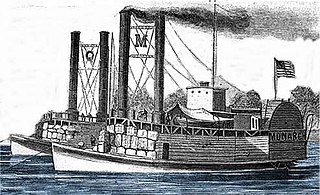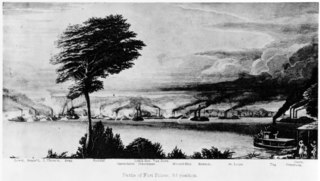Related Research Articles
At least seven United States Navy ships have been named Alabama, after the southern state of Alabama.
Six ships of the United States Navy have been named USS Tennessee in honor of the 16th state.

USS Choctaw was a large (1,004-ton) steamer built for the merchant service, but acquired by the Union Navy during the second year of the American Civil War.

CSS Tennessee was a casemate ironclad ram built for the Confederate Navy during the American Civil War. She served as the flagship of Admiral Franklin Buchanan, commander of the Mobile Squadron, after her commissioning. She was captured in 1864 by the Union Navy during the Battle of Mobile Bay and then participated in the Union's subsequent Siege of Fort Morgan. Tennessee was decommissioned after the war and sold in 1867 for scrap.

CSS Baltic was an ironclad warship that served in the Confederate States Navy during the American Civil War. A towboat before the war, she was purchased by the state of Alabama in December 1861 for conversion into an ironclad. After being transferred to the Confederate Navy in May 1862 as an ironclad, she served on Mobile Bay off the Gulf of Mexico. Baltic's condition in Confederate service was such that naval historian William N. Still Jr. has described her as "a nondescript vessel in many ways". Over the next two years, parts of the ship's wooden structure were affected by wood rot. Her armor was removed to be put onto the ironclad CSS Nashville in 1864. By that August, Baltic had been decommissioned. Near the end of the war, she was taken up the Tombigbee River, where she was captured by Union forces on May 10, 1865. An inspection of Baltic the next month found that her upper hull and deck were rotten and that her boilers were unsafe. She was sold on December 31, and was likely broken up in 1866.

SS Republic was a sidewheel steamship, originally named SS Tennessee, lost in a hurricane off the coast of Georgia in October 1865, en route to New Orleans.

The Battle of Elizabeth City of the American Civil War was fought in the immediate aftermath of the Battle of Roanoke Island. It took place on 10 February 1862, on the Pasquotank River near Elizabeth City, North Carolina. The participants were vessels of the U.S. Navy's North Atlantic Blockading Squadron, opposed by vessels of the Confederate Navy's Mosquito Fleet; the latter were supported by a shore-based battery of four guns at Cobb's Point, near the southeastern border of the town. The battle was a part of the campaign in North Carolina that was led by Major General Ambrose E. Burnside and known as the Burnside Expedition. The result was a Union victory, with Elizabeth City and its nearby waters in their possession, and the Confederate fleet captured, sunk, or dispersed.
Three ships in the Confederate States Navy were named CSS Tennessee

USS Monarch was a United States Army sidewheel ram that saw service in the American Civil War as part of the United States Ram Fleet and the Mississippi Marine Brigade. She operated on the Mississippi River and Yazoo River during 1862 and 1863.

CSS General Earl Van Dorn was a cottonclad warship used by the Confederate States of America during the American Civil War. General Earl Van Dorn was purchased for Confederate service at New Orleans, Louisiana, in early 1862 to serve with the River Defense Fleet. She was converted into a cottonclad warship by installing an iron-covered framework of timbers to her bow that served as a ram, and protecting her machinery with timber bulkheads packed with cotton. A sidewheel steamer, she was 182 feet (55 m) long and was armed with a single 32-pounder cannon on the bow. Having been assigned to defend the upper Confederate-held portion of the Mississippi River, General Earl Van Dorn left New Orleans in late March 1862 and arrived at Memphis, Tennessee, early the next month. On May 10, she fought with the River Defense Fleet against the Union Navy in the Battle of Plum Point Bend, where she rammed and sank the ironclad USS Mound City. On June 6, General Earl Van Dorn was the only vessel of the River Defense Fleet to escape destruction or capture at the First Battle of Memphis. After withdrawing up the Yazoo River to Liverpool Landing, Mississippi, General Earl Van Dorn was burnt by the Confederates along with two other Confederate ships to prevent their capture by approaching Union vessels.
USS Mobile was a steamer captured by the Union Navy during the American Civil War. She was used by the Union Navy as part of blockade forces to prevent Confederate forces from trading with other countries.

USS Silver Lake was a steamer purchased by the Union Navy during the American Civil War.

USS Sumter was a 525-ton sidewheel paddle steamer captured by the Union Navy during the Union blockade of the American Civil War.
The order of battle for the Union and Confederate forces at the Battle of Mobile Bay on August 5, 1864.

During the American Civil War, blockade runners were used to get supplies through the Union blockade of the Confederate States of America that extended some 3,500 miles (5,600 km) along the Atlantic and Gulf of Mexico coastlines and the lower Mississippi River. The Confederacy had little industrial capability and could not indigenously produce the quantity of arms and other supplies needed to fight against the Union. To meet this need, numerous blockade runners were constructed in the British Isles and were used to import the guns, ordnance and other supplies that the Confederacy desperately needed, in exchange for cotton that the British textile industry needed greatly. To penetrate the blockade, these relatively lightweight shallow draft ships, mostly built in British shipyards and specially designed for speed, but not suited for transporting large quantities of cotton, had to cruise undetected, usually at night, through the Union blockade. The typical blockade runners were privately owned vessels often operating with a letter of marque issued by the Confederate government. If spotted, the blockade runners would attempt to outmaneuver or simply outrun any Union Navy warships on blockade patrol, often successfully.
CSS Maurepas was a sidewheel steamer that briefly served as a gunboat in the Confederate States Navy during the American Civil War. Built in 1858 in Indiana as Grosse Tete, the vessel was used in commercial trade until 1860 and then delivered mail until 1861, when she was acquired by the Confederate Navy.
A number of steamships were named Tennessee, including:

The Huntsville-class ironclads consisted of two casemate ironclads ordered by the Confederate States Navy in 1862 to defend Mobile, Alabama, during the American Civil War. Completed the following year, they used propulsion machinery taken from steamboats, and were intended to be armored with 4 inches (102 mm) of wrought iron and armed with four cannons. Both CSS Tuscaloosa and her sister ship CSS Huntsville were found to be too slow for practical use, and were relegated to service as floating batteries. Union forces captured Mobile in April 1865, and the sisters were scuttled on April 12, as they were unable to escape due to an inability to steam against the current on the Spanish River.
References
- ↑ "SS Tennessee (+1942)". Wreck Site .eu.
- ↑ "M/S Tennessee". WarSailors.com. 24 August 2012.
- ↑ "TENNESSEE — Cargo ship, MMSI 227095770". Vessel Finder .com.
- ↑ "BBC TENNESSEE". Fleet Mon .com.
- ↑ "MAERSK TENNESSEE (IMO 7717169) - General Cargo Ship". Vessel Tracking .net.